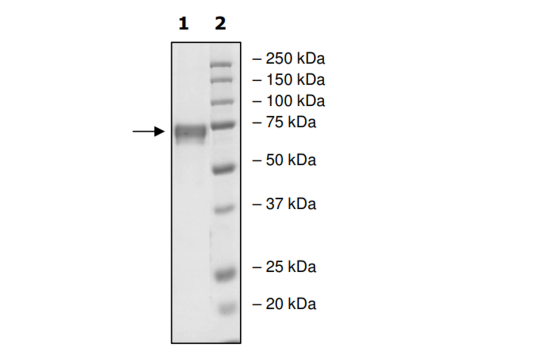TAK1-TAB1, GST-tag Recombinant
Catalog #
40279
$385
*
●
●
Purchase
Description
Recombinant fusion protein consisting of human proteins TAK1 (TGFβ-activated kinase 1), also known as MAP3K7 (Mitogen-activated protein kinase kinase kinase 7), Genbank Accession #NM_003188, a.a. 1-303, and human TAB1 (TAK1-binding protein), Genbank Accession #NM_006116, a.a. 437-end, linked by a small peptide (DFGGGGG), and with an N-terminal GST-tag, MW = 69 kDa, expressed in Sf9 cells via a baculovirus expression system.
This product has been cited 1 time.
●
Synonyms
TAK1: MAP3K7, TGF1a, TGFβ-activated kinase 1
TAB1: MAP3K7IP1, 3'-Tab1, MGC57664, TAK1-binding protein
TAB1: MAP3K7IP1, 3'-Tab1, MGC57664, TAK1-binding protein
●
Product Data Gallery
Product Info
Storage and Usage
Citations1
Species
Human
Host Species/Expression System
Sf9 insect cells
Purity
≥90%
Format
Aqueous buffer solution
Formulation
40 mM Tris-HCl, pH 8.0, 110 mM NaCl, 2.2 mM KCl, 3 mM DTT and 20% glycerol.
MW
69 kDa
Amino Acids
TAK1 (1–303), TAB1 (437–end)
Genbank #
NM_003188, NM_006116
UniProt #
O43318(TAK1), Q15750 (TAB1)
Background
TAK1 is a serine/threonine protein kinase that mediates signaling by TGFβ and morphogenetic protein (BMP) (1). In response to IL-1, TAK1 forms a kinase complex with TAB1 and this complex is required for the activation of nuclear factor kappa B (Nf?B). TAK1 can also activate MAPK8/JNK and MAP2K4/MKK4 and thus play a role in the cell response to environmental stress. Tak1 is essential for thymocyte development and activation and deletion of TAK1 prevents maturation of single-positive thymocytes displaying CD4 or CD8 (2). Thymocytes lacking TAK1 fail to activate Nf?B and JNK and are prone to apoptosis upon stimulation.
References
1.Yamaguchi, K. et al. Science 270: 2008-2011, 1995.
2.Liu, H.-H. et al. Proc. Nat. Acad. Sci. 103: 11677-11682, 2006.
3. Sakurai, H., et al. (2000). FEBS Lett. (Netherlands) 474 (2-3): 141–5.
4. Liu, H.-H., et al. (2006). Proc. Natl. Acad. Sci. USA 103: 11677-11682.
2.Liu, H.-H. et al. Proc. Nat. Acad. Sci. 103: 11677-11682, 2006.
3. Sakurai, H., et al. (2000). FEBS Lett. (Netherlands) 474 (2-3): 141–5.
4. Liu, H.-H., et al. (2006). Proc. Natl. Acad. Sci. USA 103: 11677-11682.



